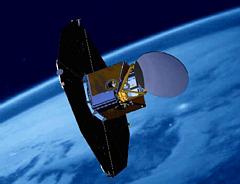- display options ▼
- normal
- full width
 |
Odin |  |
 Odin is an international astronomy and aeronomy mission led by Sweden,
with Canada, France, and Finland as partners. Canada has a 20% share in both
aspects of the mission, with funding provided by
The Canadian Space Agency
and by
The Natural Science and Engineering Research Council.
Dr. Kwok is the Principal Investigator for Astronomy
in Canada.
Odin was launched from Svobodny, Siberia on February 20, 2001.
The duration of the mission
was expected to be 2 years.
Odin is an international astronomy and aeronomy mission led by Sweden,
with Canada, France, and Finland as partners. Canada has a 20% share in both
aspects of the mission, with funding provided by
The Canadian Space Agency
and by
The Natural Science and Engineering Research Council.
Dr. Kwok is the Principal Investigator for Astronomy
in Canada.
Odin was launched from Svobodny, Siberia on February 20, 2001.
The duration of the mission
was expected to be 2 years.
Odin provided astronomical and aeronomical measurements for nearly seven years, from February 2001 through to the end of 2007. While still in orbit, Odin operations were shut down for financial reasons. We still hope to switch systems on again for exceptional opportunities.
Odin operates in four sub-millimetre bands, centred on 495, 548, 555 and 571 GHz. The radiometer provides a 17 GHz tuning range about each of these frequencies and has an instantaneous bandwidth of 1 GHz. There is also be a fifth band in the millimetre range centred on 119 GHz. The spatial resolution is ~2 arcmin at sub-millimetre wavelengths and ~9 arc min at 119 GHz. Many molecular and atomic lines of astronomical interest are accessible for the first time. A major goal is to study the interstellar and circumstellar oxygen chemistry using water and oxygen molecules. These species are key to the oxygen budget but neither is detectable from the ground. Odin observations have an impact on a wide range of subjects including molecular cloud chemistry, shock chemistry, star-forming cores, circumstellar envelopes, interstellar clouds, photodissociation regions, comets, planetary atmospheres, and extragalactic molecules. The University of Calgary participates both in the building of the submm receiver payload and in software simulations.